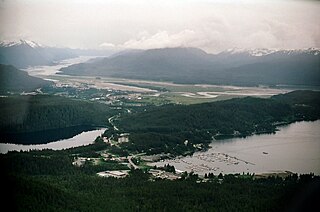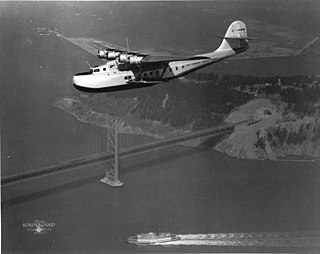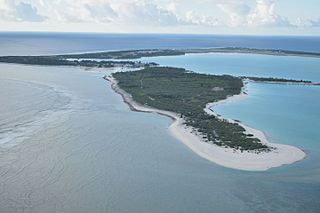China Clipper was the first of three Martin M-130 four-engine flying boats.
China Clipper may also refer to:

A clipper was a type of mid-19th-century merchant sailing vessel, designed for speed. The term was also retrospectively applied to the Baltimore clipper, which originated in the late 18th century.

Pan American World Airways, originally founded as Pan American Airways and more commonly known as Pan Am, was an airline that was the principal and largest international air carrier and unofficial overseas flag carrier of the United States for much of the 20th century. It was the first airline to fly worldwide and pioneered numerous innovations of the modern airline industry, such as jumbo jets and computerized reservation systems. Until its dissolution on December 4, 1991, Pan Am "epitomized the luxury and glamour of intercontinental travel", and it remains a cultural icon of the 20th century, identified by its blue globe logo, the use of the word "Clipper" in its aircraft names and call signs, and the white uniform caps of its pilots.

China Clipper (NC14716) was the first of three Martin M-130 four-engine flying boats built for Pan American Airways and was used to inaugurate the first commercial transpacific airmail service from San Francisco to Manila on November 22, 1935. Built at a cost of $417,000 by the Glenn L. Martin Company in Baltimore, Maryland, it was delivered to Pan Am on October 9, 1935. It was one of the largest airplanes of its time.

The Boeing 314 Clipper was an American long-range flying boat produced by Boeing from 1938 to 1941. One of the largest aircraft of its time, it had the range to cross the Atlantic and Pacific oceans. For its wing, Boeing re-used the design from the earlier XB-15 bomber prototype. Twelve Clippers were built, nine of which served with Pan Am.
A clipper is a type of fast sailing vessel, generally from the 19th century.

Edwin Charles Musick was chief pilot for Pan American World Airways and pioneered many of Pan Am's transoceanic routes including the famous route across the Pacific Ocean, ultimately reaching the Philippine Islands, on the China Clipper.

The Sikorsky S-42 was a commercial flying boat designed and built by Sikorsky Aircraft to meet requirements for a long-range flying boat laid out by Pan American World Airways in 1931. The innovative design included wing flaps, variable-pitch propellers, and a tail-carrying full-length hull. The prototype first flew on 29 March 1934, and, in the period of development and test flying that followed, quickly established ten world records for payload-to-height. The "Flying Clipper" and the "Pan Am Clipper" were other names for the S-42.

The Marine Air Terminal is an airport terminal located at LaGuardia Airport in Queens, New York City. Its main building, designed in the Art Deco style by William Delano of the firm Delano & Aldrich, opened in 1940. The terminal was built to handle Pan Am's fleet of flying boats, the Boeing 314 Clippers, which landed on the nearby Bowery Bay. Technological advances after World War II made the Clippers obsolete, and the Marine Air Terminal was renovated in 1946 to serve conventional planes. As of April 2024, the terminal is used by Spirit Airlines for flights to various destinations around the U.S.

The Sikorsky S-40 was an American amphibious flying boat built by Sikorsky in the early 1930s for Pan American Airways. During WW2 they were used by the United States Navy for training.

Naval Air Station Alameda was a United States Navy Naval Air Station in Alameda, California, on San Francisco Bay.

The Martin 156, referred to in the press variously as the "Russian Clipper", "Moscow Clipper", or "Soviet Clipper" was a very large flying boat aircraft intended for trans-Pacific service. The single example of the M-156 was designed and built in response to a request from Pan American World Airways to provide a longer-range replacement for the Martin M-130.

The Martin M-130 was a commercial flying boat designed and built in 1935 by the Glenn L. Martin Company in Baltimore, Maryland, for Pan American Airways. Three were built: the China Clipper, the Philippine Clipper and the Hawaii Clipper. All three had crashed by 1945. A similar flying boat design called the Martin 156 and named Russian Clipper, was built for the Soviet Union; it had a larger wing and twin vertical stabilizers.

Auke Bay is a neighborhood located in the city and borough of Juneau, Alaska, that contains Auke Bay Harbor, Auke Lake, the University of Alaska Southeast, an elementary school, a church, a post office, a bar, a coffee shop, a waffle house, a thrift shop, a Thai restaurant, and one convenience store.

The Alameda Mole was a transit and transportation facility in Alameda, California for ferries landing in the East Bay of San Francisco from 1878 to the 1930s. It was located on the west end of Alameda, and later became part of the Alameda Naval Air Station. It was one of four neighboring moles. The others were the Oakland Mole, the WP Mole, and the Key System Mole. The purpose of the mole was to extend tracks of rail-based transportation lines beyond the shallow mud flats along the shore of the East Bay into water deep enough to accommodate the passenger and rail ferries to San Francisco.

Pan Am Flight 1104, trip no. 62100, was a Martin M-130 flying boat nicknamed the Philippine Clipper that crashed on the morning of January 21, 1943, in Northern California. The aircraft was operated by Pan American Airways, and was carrying ten US Navy personnel from Pearl Harbor, Hawaii, to San Francisco, California. The aircraft crashed in poor weather into mountainous terrain about 7 mi (11 km) southwest of Ukiah, California.

The Memnon was the first clipper ship to arrive in San Francisco after the Gold Rush, and the only clipper to arrive in San Francisco before 1850. Built in 1848, she made record passages to San Francisco and to China, and sailed in the first clipper race around Cape Horn.

The China Clipper flight departure site is listed as California Historical Landmark number 968. It is the site from which Pan American World Airways initiated trans-Pacific airmail service on November 22, 1935. A flying boat named China Clipper made the first trip, and the publicity for that flight caused all flying boats on that air route to become popularly known as China Clippers. For a few years, this pioneering mail service captured the public imagination like the earlier Pony Express, and offered fast luxury travel like the later Concorde.

Hawaii Clipper was one of three Pan American Airways Martin M-130 flying boats. It disappeared with six passengers and nine crew en route from Guam to Manila, on July 28, 1938.

Honolulu Clipper was the prototype Boeing 314 flying boat designed for Pan American Airways. It entered service in 1939 flying trans-Pacific routes.

Peale Island is one of three islands in the Wake Island atoll, which lies in the Pacific Ocean between Guam and Midway. The atoll was from 1935 the site of a seaplane base and a hotel built by Pan-American, who started the first transpacific passenger service using a string of islands across the Pacific to fly between America and Asia in stages. The island, like the rest of Wake, is made of coral fragments and sand, atop a seamount, and ringed by a living coral reef. The island is heavily forested with tropical scrub, trees, and grasses and is inhabited mainly by birds, rats, and hermit crabs. In the late 20th century, it was the site of a United States Coast Guard Loran Station, supporting radio navigation prior to satellite systems. The island is home to many historical items, including the Pan-American Hotel and remnants of World War II, such as bunkers and a rusted 8-inch coastal defense gun.